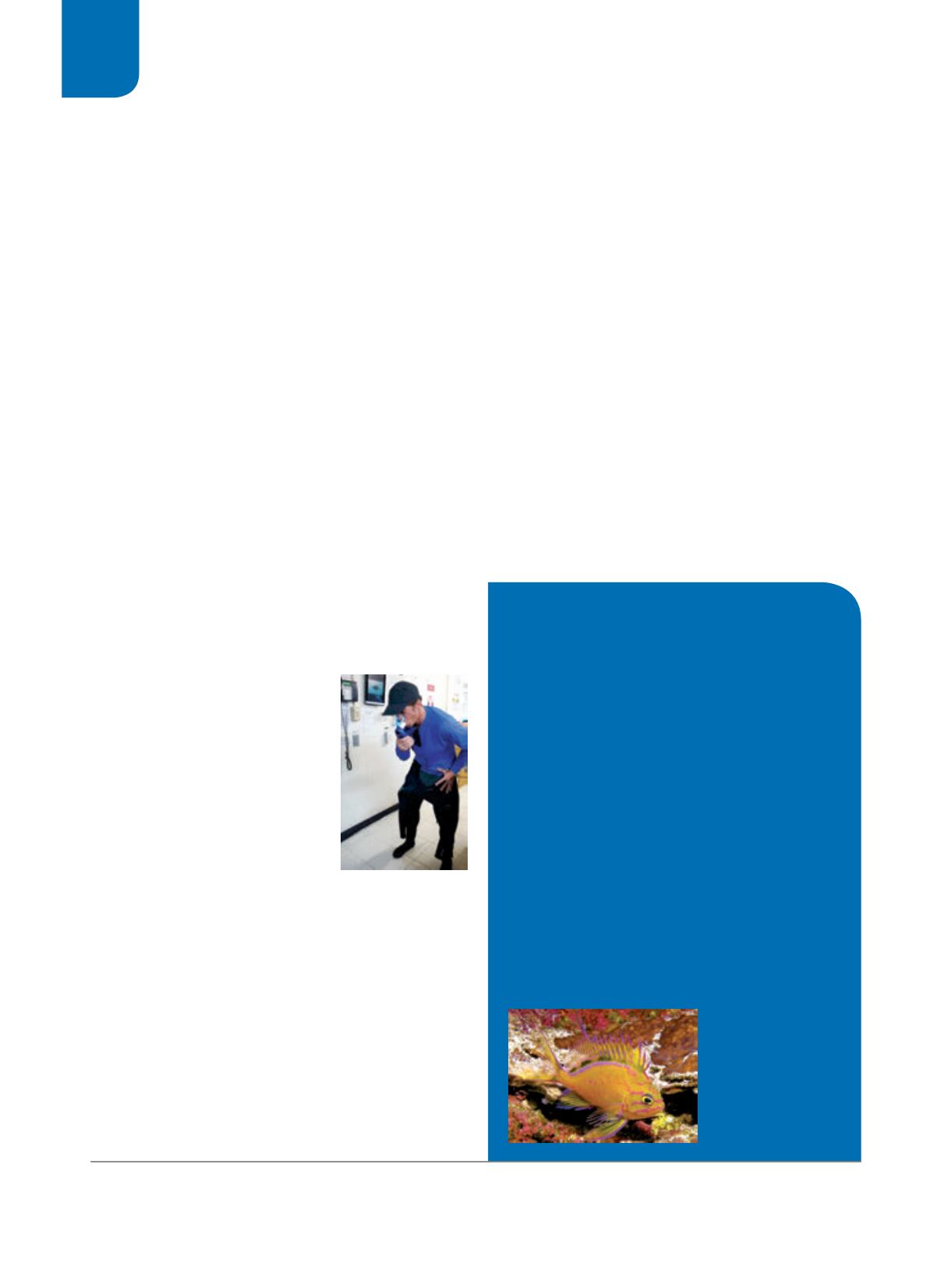

24
|
WINTER 2017
DIVE SLATE
DEEP STUDY
in time. The challenge is in understanding how and
when multiple factors may or may not be important.
Both lab and field studies are necessary to better
understand decompression stress and risk.
Lab studies in a controlled environment such as a
hyperbaric chamber are a critical element in evaluating
the impact of factors such as pressure, exercise and
thermal stress on DCS risk. The ability to isolate
these and other variables is an important benefit of
lab research. Field studies are less controlled, but they
incorporate realistic conditions that generally cannot
be fully reproduced in the lab. In field studies, multiple
factors work together to produce an overall impact on
physiology and, subsequently, DCS risk. Although the
idiosyncrasies of field studies can make it challenging
to test hypotheses and develop publishable science, the
results can better reflect real-world activities.
The latest NOAA expedition was organized by
Randall Kosaki, Ph.D., deputy superintendent of
research and field operations. This project included
collaborative work with a scientific team from DAN®
led by DAN research director Neal Pollock, Ph.D.
The collaboration gave these researchers access to an
extensive dive series that would be both difficult and
expensive to set up in a lab.
FIELD DIVE MONITORING
Studying decompression dive
profiles in the field presents a
unique opportunity to better
understand the impact of these
exposures, particularly on bubble
formation and DCS risk. Being
able to follow a single group of
divers for an extended period offers
insights that could not be found in
a shorter series. NOAA’s facilities
and pool of scientific and working
divers support a broad range of
dives. Typically, NOAA divers
dive 20-minute bottom times at 280-330 feet followed by
approximately 80-120 minutes of decompression.
Subjects in field dive-monitoring studies have access to
real-time measures of decompression stress following their
dives. For example, transthoracic echocardiography (TTE)
uses ultrasound to create moving images of the chambers
of the heart and any visible bubbles that may be present
postdive. Both the subjects and the program benefit by
viewing such measures of decompression stress that they
would normally not be able to see. The resulting insights
can prompt modification of individual behaviors and
possibly even the operational practices of the dive program.
Improved use of conservatism in risk management may
lead to increased consideration of idiosyncrasies in human
physiology, which has relevance for all divers.
COLLABORATIVE EFFORTS
Studying scientific divers engaged in dynamic and extreme
dive profiles provides an opportunity to see whether the
dive computers and models on which they rely adequately
control for bubble formation. It also provides an
opportunity to study whether more conservative settings
might help reduce the risk of DCS. Better understanding
of the interplay between decompression stress and the
various factors that affect physiology can provide insights
into DCS risk. The lessons learned through this research
may lead to safer diving, not just for these research divers
but for the entire scientific and possibly recreational
diving communities.
AD
Reference
1. Muir P, Wallace C, Bridge TCL, Bongaerts P. Diverse staghorn coral fauna on the mesophotic reefs of North-East Australia. PLoS One. 2015; 10(2): e0117933.
THE VESSEL
Hi‘ialakai
, Hawaiian for “embracing pathways to the sea,”
is a critical part of the mission to explore, understand and
protect the coral reef habitats of PMNM. Its scientific operations
include field studies that map coral reef ecosystems, perform
bioanalysis assessments, gauge coral reef health and study fish
stocks. In addition to carrying small work boats for transporting
divers to and from working areas, the 224-foot research vessel
also carries a three-person, dual-lock recompression chamber;
in the event of a dive accident, the diver can be treated on site.
NEW SPECIES
The number of known fish species in PMNM has grown by more
than 25 percent, which amounts to a significant increase in
known biodiversity. More than 70 species of colorful algae formerly
unknown to science have been collected. The latest expedition
discovered that the fish communities on deep reefs at 330 feet
at Kure Atoll (the northernmost reef in the Hawaiian archipelago)
are composed of 100 percent endemic species (species found
nowhere else). This is a level of endemism never before seen in
any other marine ecosystem on Earth.
A yellow anthias,
Odontanthias
fuscipinnis
, adorns
the reef at 300 feet at
Midway Atoll.
Diver Daniel Wagner
undergoes spirometry
testing aboard the
research vessel
Hi’ialakai
.
NEAL POLLOCK
RICHARD PYLE, BISHOP MUSEUM


















